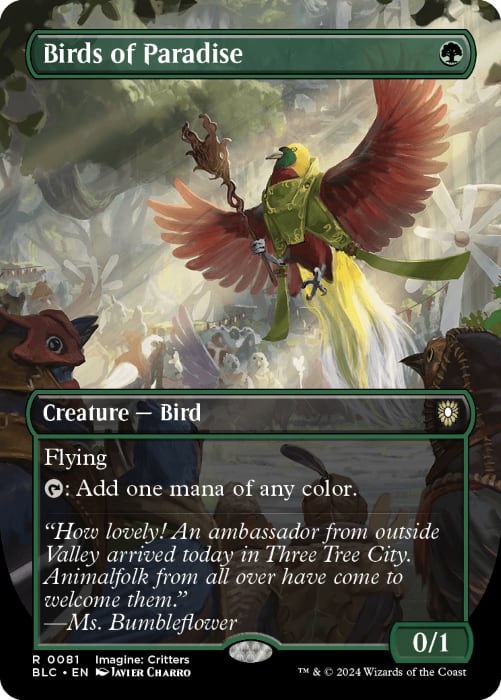Let's talk about flying. No, not the kind that requires an expensive airline ticket to get to the next MagicCon. No, instead, in today's Mechanics Overview Segment, we're going to be talking about the mechanic, Flying, an evergreen ability that has been making all your opponents scream, "Wait, I can't block that?!" since the olden days of Richard Garfield rummaging around in his design notebook.
What is Flying?
This creature can't be blocked except by creatures with Flying or reach.
Flying is, first and foremost, categorized as an evasion ability, which dictates how your creature can be blocked. So, to keep things short and sweet, if a creature has Flying, it can't be blocked by something on the ground unless that something also has Flying and/or Reach. Simple. Elegant. And kind of broken if you think about it.
The History of Flying
Flying cards were first introduced in Magic's first set, Alpha (1993), making it one of the game's oldest and most revered mechanics. Legends say it was the very first mechanic Richard Garfield himself conceptualized for Magic. (Legends also say Garfield may have once tried to fly himself, but that rumor remains unverified. We do know he was wise enough to give that ability to fictional creatures rather than humankind, so points for that decision.)
Since then, more than 5,000 different cards have soared into the game with the Flying keyword. From Birds of Paradise to the dreaded Commander All-star Consecrated Sphinx and from Angels that hold heavenly secrets to Dragons that ravage entire planes, Flying creatures undoubtedly represent some of the most flavorfully resonant and mechanically punishing aspects of the game.
This mechanic is so popular, in fact, that Ikoria: Lair of Behemoths (2020) recently took things a step further with the introduction of Flying Counters; yep, these are permanent tokens that you can randomly slap onto your creatures so they can suddenly sprout wings. Because who doesn't want to watch their random Grizzly Bears become a Flying ursine menace, right?
Flying in the MTG Color Pie
Now, you might be wondering which colors love the air and which get left behind on the ground.
Here's a quick breakdown:
- Blue: The undisputed champion of aerial dominance. Winged Drakes, Leviathans that weirdly also float, Illusions with flight, Blue simply adores throwing creatures in the sky.
- White: Where Angels and Pegasi gather to remind you that justice can come from above, literally. White is likely the second-most prolific color for fliers.
- Black: Demons and Harpies, oh my! Not as air-happy as Blue or White, but Black definitely invests in flight somewhat.
- Red: Dragons, Dragons, Dragons. Did I mention Dragons? They often cost a fair bit of mana, but few creatures can match the awe and fear a big Red dragon instills when it hits the battlefield.
- Green: The color that loves the ground so much that it rarely invests in the air. But keep in mind that Green is often the best at shooting down flyers with their namesake cards like Plummet or Hurricane.
The Metagame Value of Flying
Flying tends to be the most relevant in Limited formats like Draft or Sealed. Whenever you see a card like Wind Drake, it might not look like a bomb, but trust me, that three-mana 2/2 body with evasion can become your bread-and-butter for chipping away at an opponent. For those of you less familiar with Limited by the way, the acronym many players utilize when deckbuilding, BREAD (Bombs, Removal, Evasion, Aggro, Duds), is especially relevant here as Flying creatures should always be near the top of that priority scale because of how well they close out games.
And even in multiplayer formats like Commander, where you have extra life totals or more complicated board states, a well-timed flier or Flying-synergy piece can quickly spiral out of control. Then again, so can your pod's aggression towards you if they catch wind (haha, Flying puns) that you're piling up an unstoppable air force.
Why Flying Remains Evergreen
So, why does Wizards of the Coast keep printing Flying, set after set, sometimes in abundance, sometimes just peppered in for flavor? Because it's fun. There's a reason it's an evergreen mechanic: Flying is easy to understand, it offers straightforward gameplay benefits, and it's thematically cool.
Players, myself included, just love big, flashy creatures that swoop in from above for the kill. At the same time, they appreciate the tension of trying to figure out how to deal with these winged nightmares once they inevitably land on the battlefield. Magic is a game of problem-solving, and Flying creatures will always present a real, consistent threat.
Taking to the Skies
At the end of the day, you simply can't go wrong adding a bit of altitude to your game plan--whether you're unleashing a legion of Storm Crows to rain down upon your enemies or loading up on Reach creatures to make sure nobody else becomes airborne. Flying is, has been, and will continue to be a hallmark of Magic as a resonant, flavorful, and as elegantly simple as it is strategically complex mechanic.
So the next time you soar into combat with your Flying creatures, be sure to tip your hat to good ol' Richard Garfield. He clearly knew from the very beginning that every great fantasy battle needed at least one skybound cavalry.
And that's it from me this time! As always, happy brewing and may you always remember to slot your Plummets in the maindeck and not just the side in your next Limited event. Until next time!




























